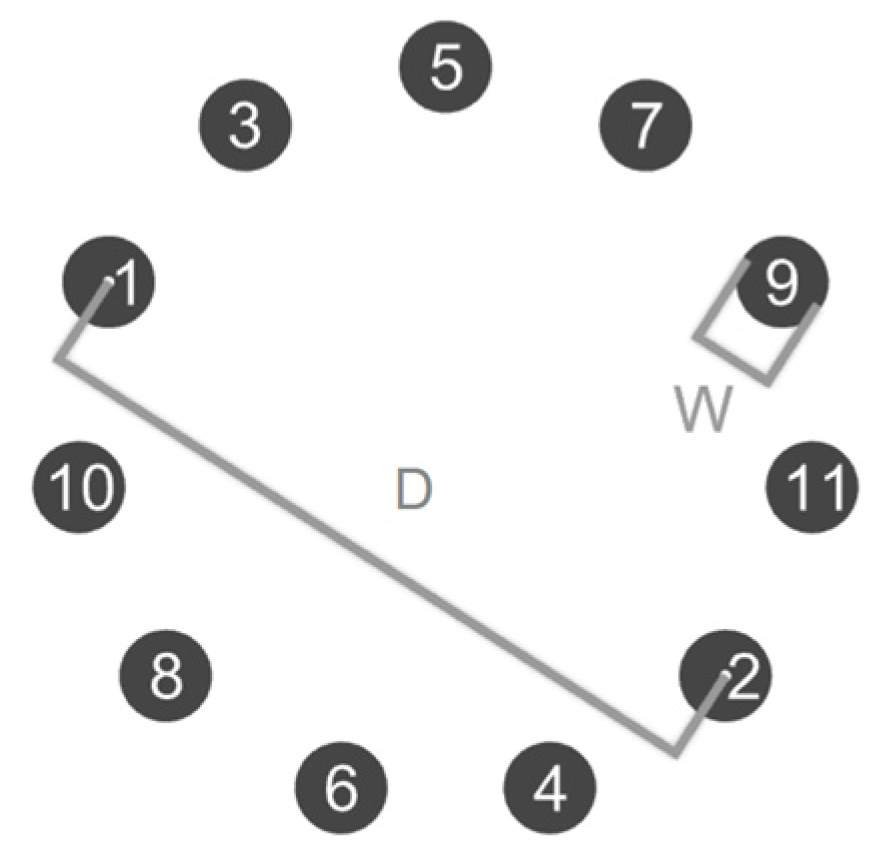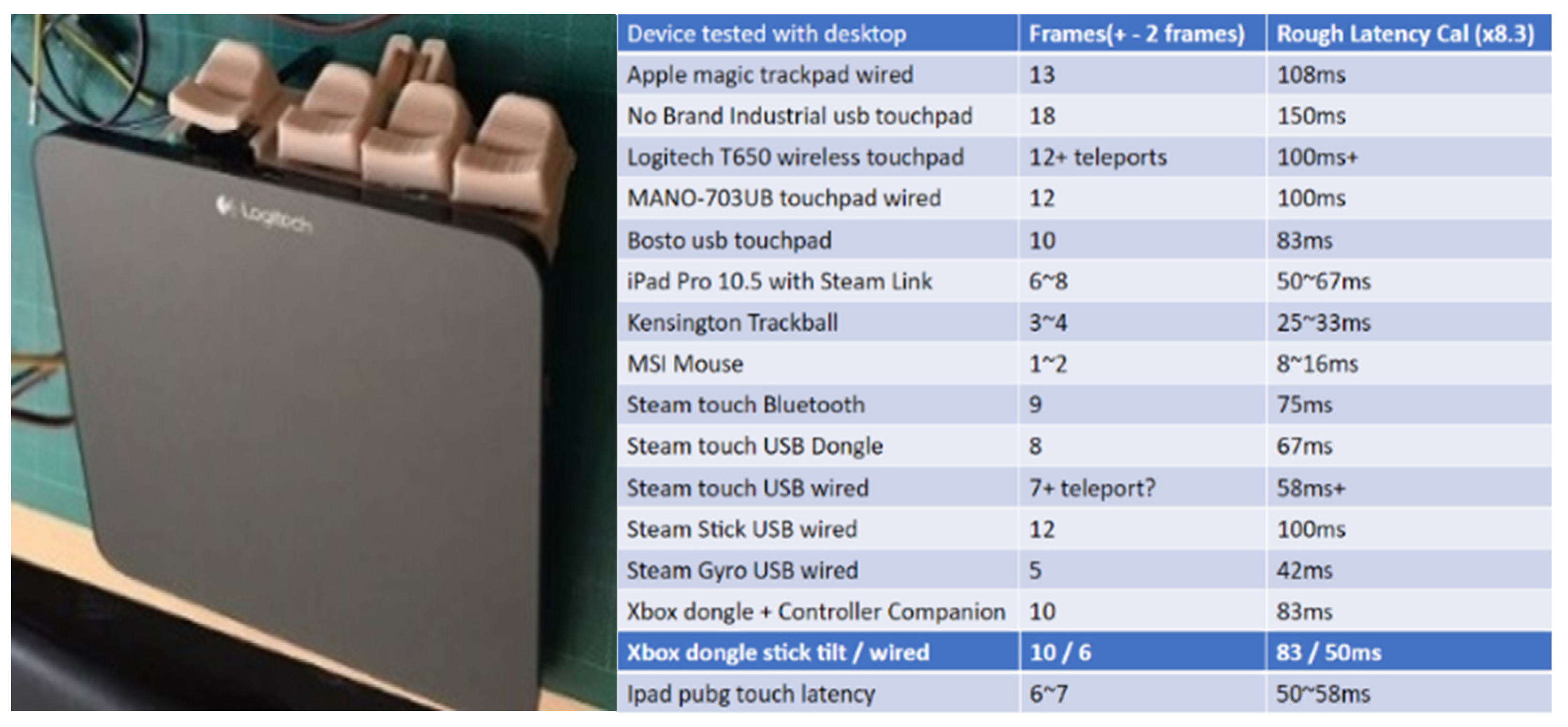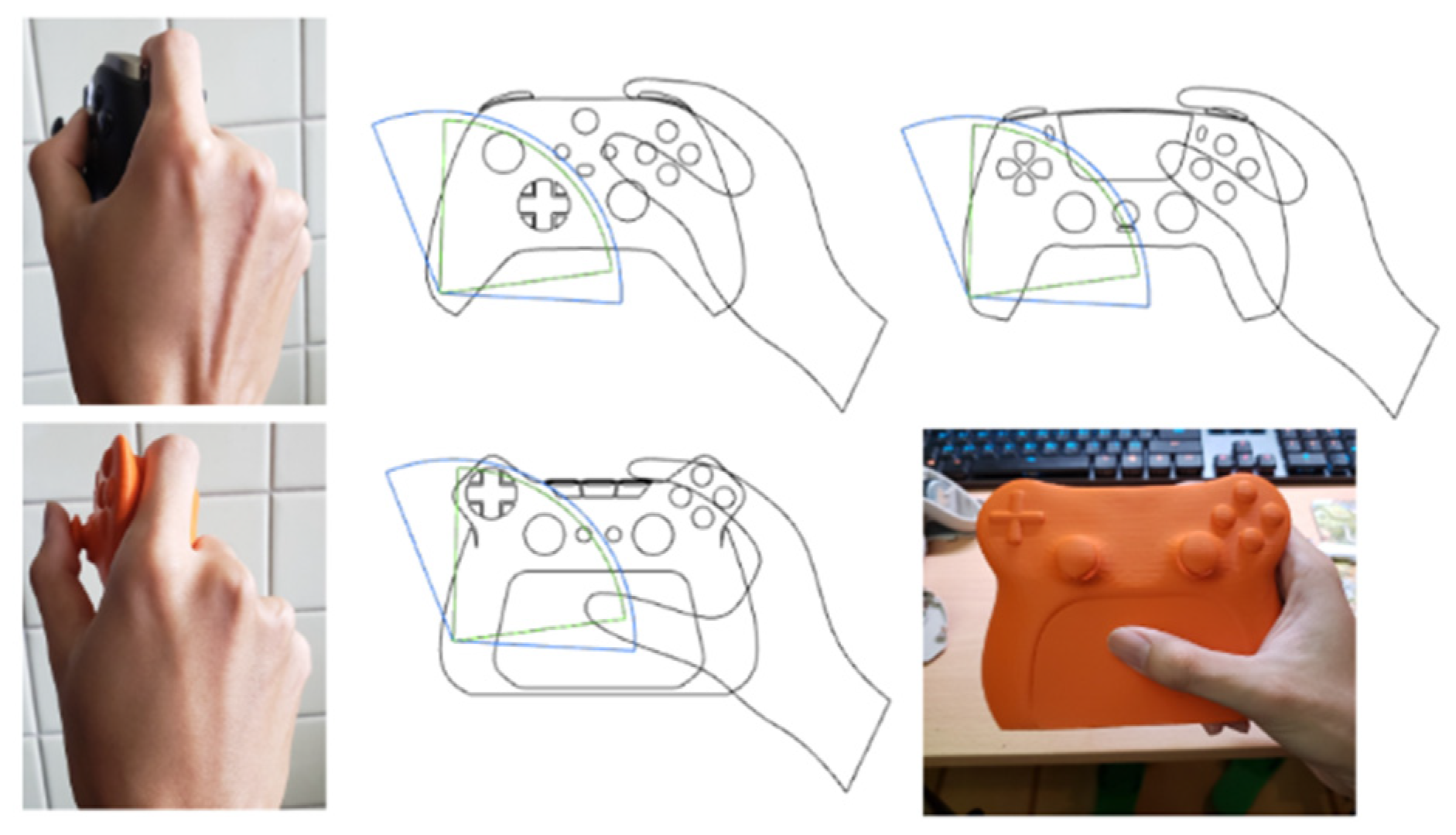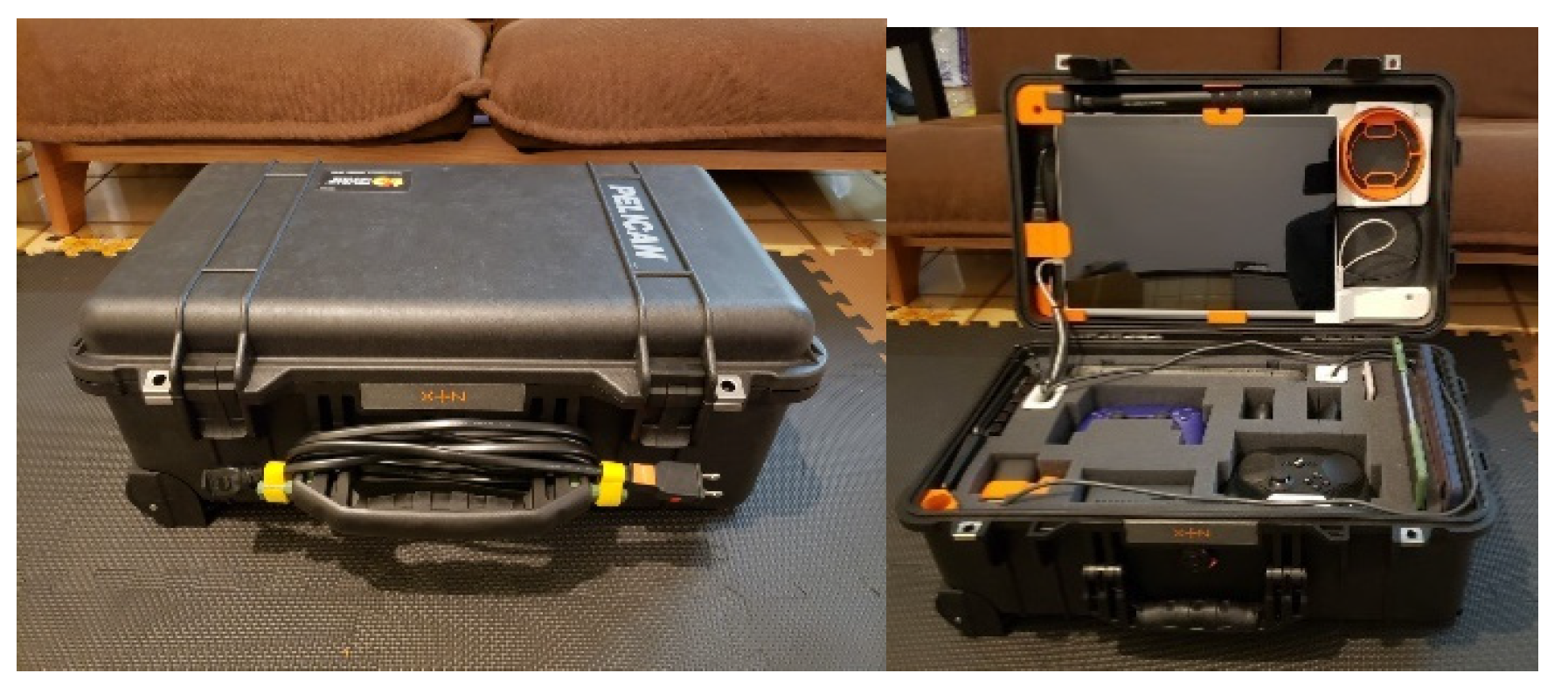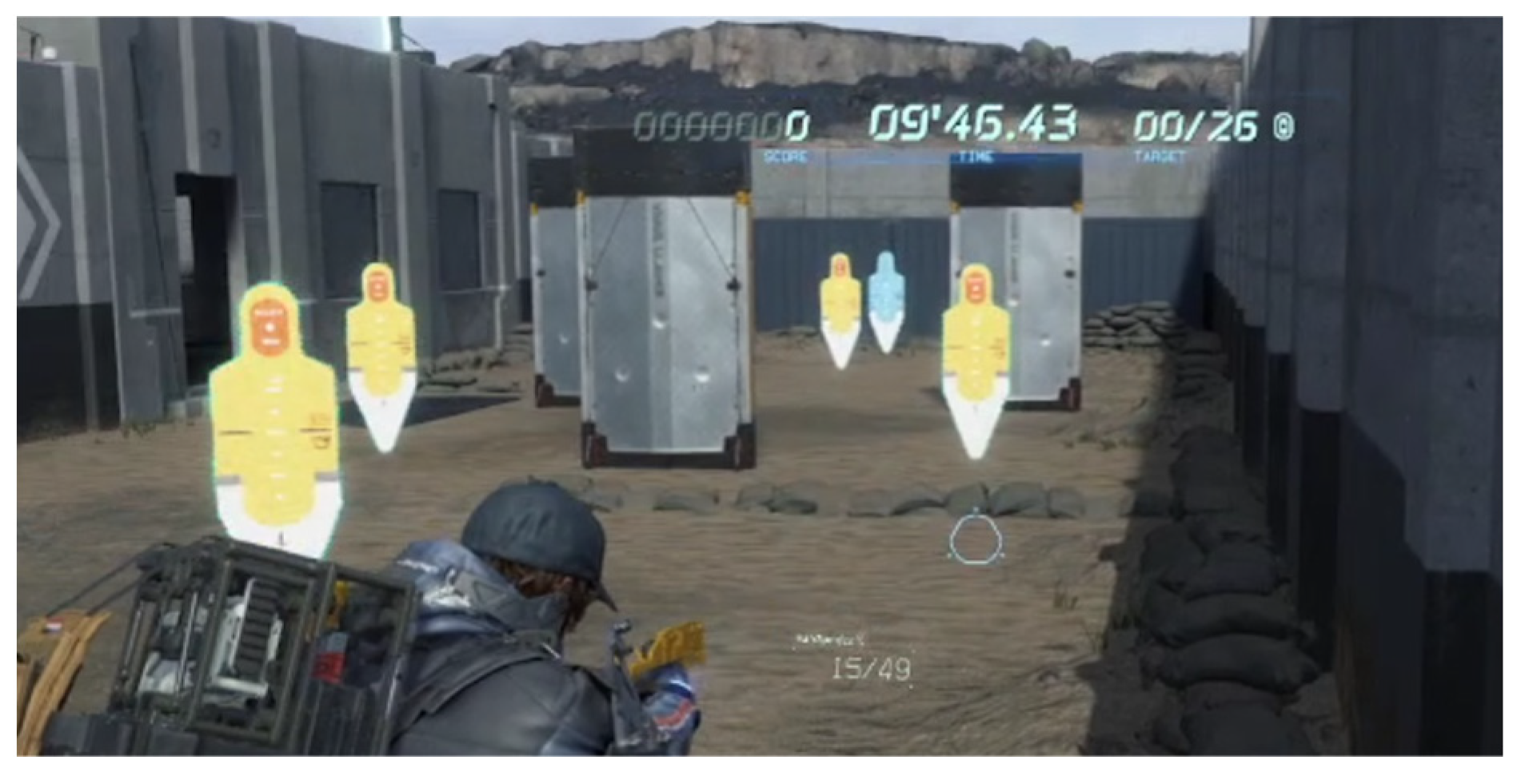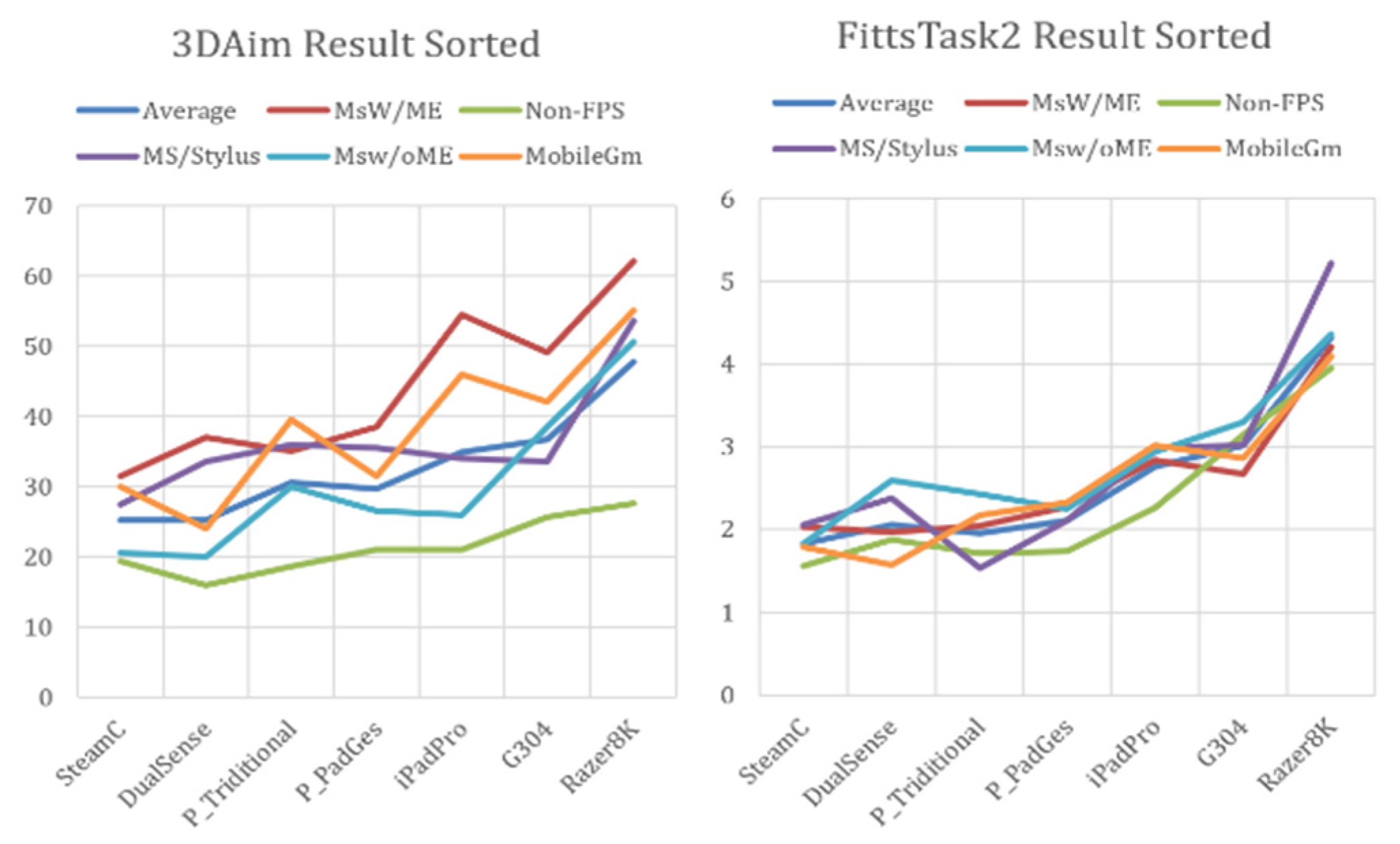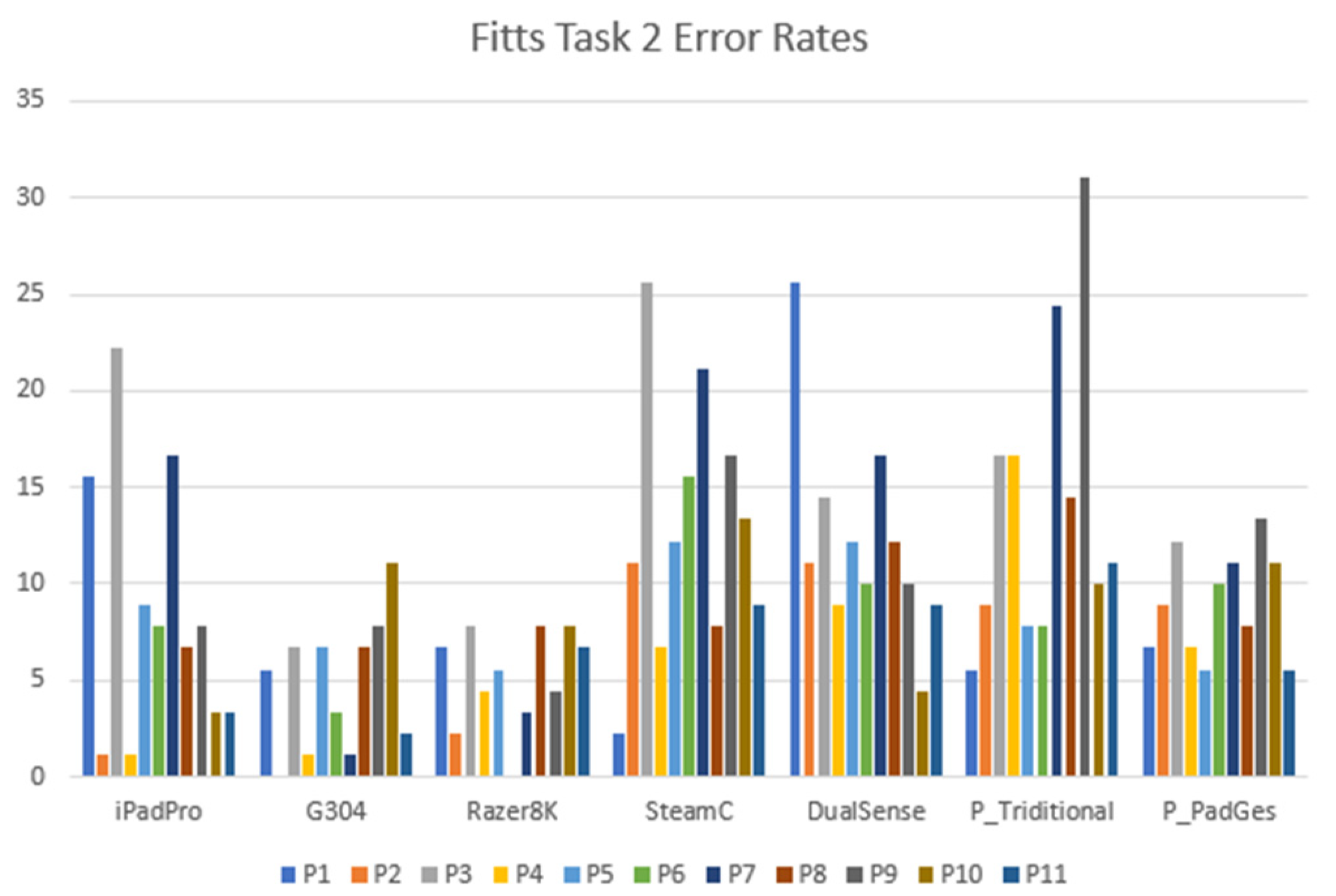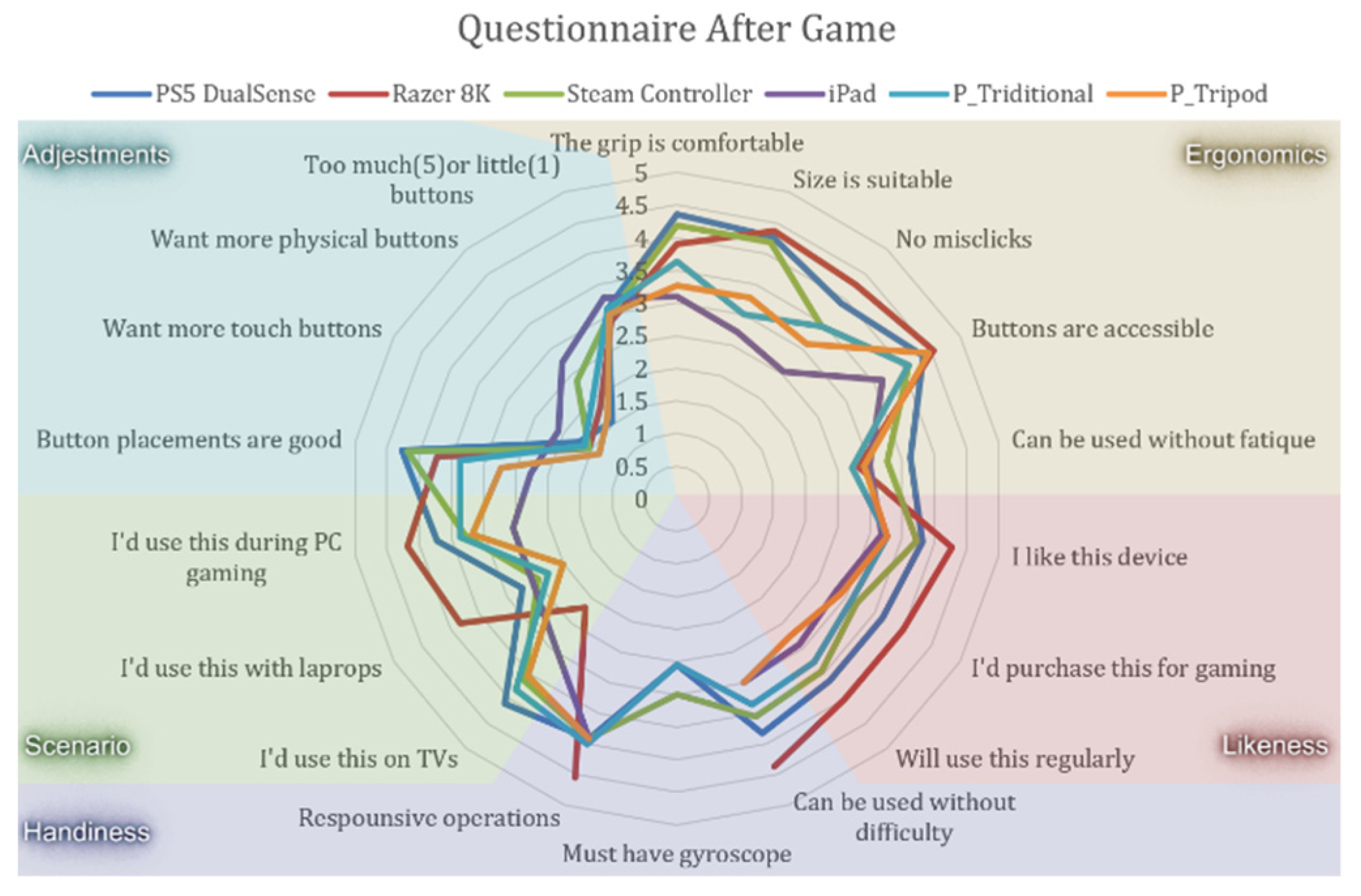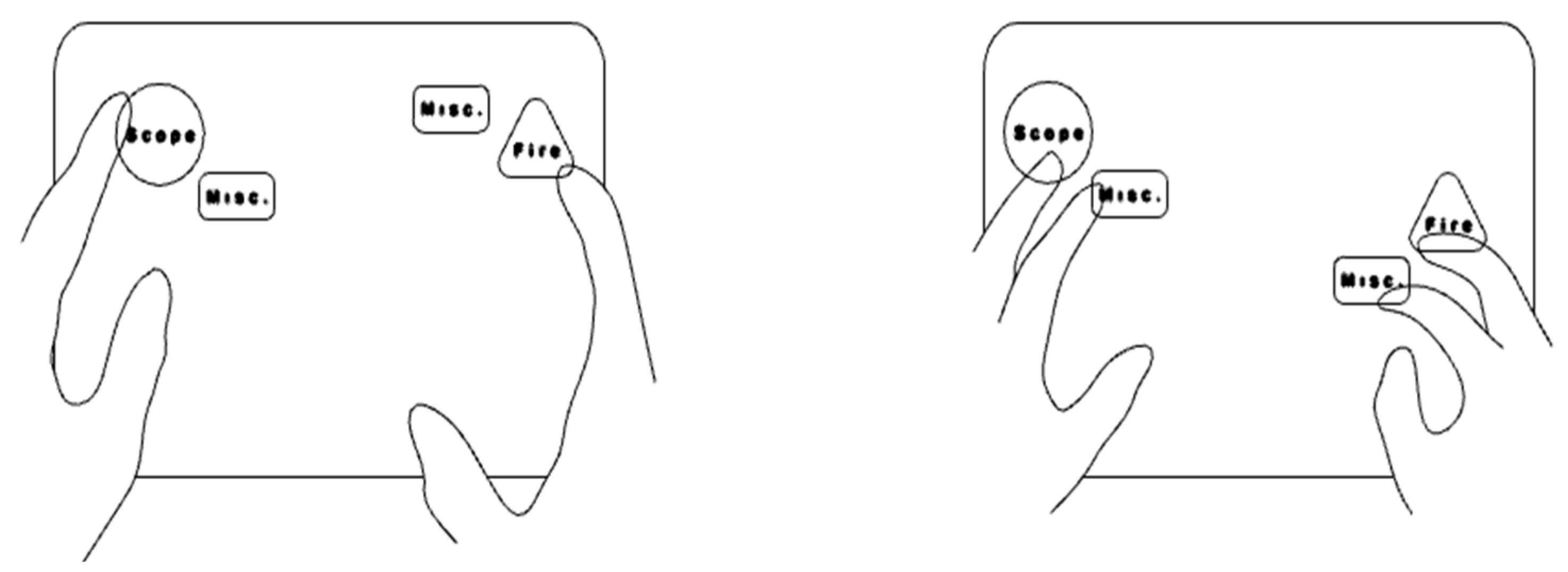1. Introduction
Shooter games have become an iconic game genre and the most popular choice across different gaming platforms [
1]. They have various input methods based on the platform’s hardware limitations. The mouse and keyboard inputs of a PC are known to be the most accurate and efficient input methods [
2]. However, console games are played with gamepads to adapt to the living room environment for diverse game genres. As they are different from a mouse providing direct coordinate information, the analog sticks on a gamepad provide vector angle data that are translated into the direction and force inputs for aiming in a game. The gamepad is inferior to the mouse in shooter game environments. Thus, game developers need to add an assist function for the players. Adding a gyro input to the gamepad is used to improve the gamepad’s functionality [
3] and its efficiency [
4].
Mobile shooter games require touch screen as a substitute for the mouse, which provides coordinated data by using a gyroscope. With the success of the PUBG Mobile on the platform [
5], many developers are porting their IPs such as Apex Legends [
6] for mobile shooter players. Companies such as Valve have attempted to transform more PC games into “mobile” ones with devices such as Steam Deck, a handheld game console for playing most of the titles developed for the PC platform. In Steam Deck, two touchpads and a gyroscope on the device replace the mouse and keyboard controls [
7]. With the advancement of the mobile gaming platform and the increasing number of players familiar with the touch and gyro input method, it is necessary to measure the players’ performance and preference for the control methods and explore the potential of touch and gyro as the norm in future gamepad designs. The participants’ gaming experience also needs to be documented to understand their experience and preference for game genres.
2. Literature Review
2.1. Fitts’ Law Testing
Fitts’ law is used to evaluate the performance of human–computer input devices. Although the pointer–background relationship is opposite to that of 3D shooter games, in games, the control moves the background, and the crosshair stays in place. The Fitts test and normal GUI interface make the pointer move with the input on the stationary background. Fitts tasks are seen as a validified method to test the performance of peripherals for shooter games [
8].
The original Fitts task experiment (now referred to as a 1D task) requires two parallel target areas, with their width determined and a certain distance. Modern tests often use a 2D version of the circular targets arranged in a circular array. As shown in
Figure 1, with the target size identified as W (width), and the distance between the pointer and target being A (amplitude), the MT movement time is measured for each task. With Equation (1), the throughput is calculated as the efficiency of the tested device (the error rate is also recorded).
2.2. Testing with Games
Testing with existing games by using in-game scores or time as data is a method to evaluate the different input methods [
9]. Opinions for playing actual games are collected too [
10] for understanding the gaming experience and performance.
2.3. History of PUBG Mobile
PUBG Mobile is one of the first battle royal games on the mobile platform that inherits the full experience from its original PC platform version [
11]. This was traced back to a game called ARMA 2, a realistic battlefield first-person shooter simulator that was used by militaries to train their soldiers. A player named Brendan Greene created a modification called DayZ inspired by titles like The Hunger Games and started the survival shooter genre. He later worked in Bluehole Studio to finally turn his vision into the game PlayerUnknown’s Battleground. Lightspeed & Quantum (a subsidiary of Tencent) created the mobile port, which later became the highest-grossing mobile game across iOS and Android [
5]. The success led Bluehole to create a mobile port of PUBG New State. As EA games cooperated with Lightspeed & Quantum to create the mobile version of Apex Legends, the number of mobile shooter games and players increased with COD M and Free Fire in the market.
A mobile phone has different hardware inputs compared to a PC or console, as these games require the touch screen for the players to customize the button location, sizes, and opacity. This results in diverse control methods between the players with phones and tablets of different sizes. However, such as PC mice, the gestures of mobile shooter players are categorized by the number of fingers they are using [
12].
Some players invest money in devices to add physical buttons to their mobile devices for better ergonomics and advantages in the game.
2.4. Devices with Similar Input Methods
Valve, the company behind the Steam platform and games, such as Half-Life, Counter Strike, Dota, Team Fortress, and Portal, can stream the PC experience to living rooms with Steam Link. They need to design a substitute for the mouse to be used on the couch. Their solution develops from replacing the mouse with a trackball and results in a gyro-included gamepad with two multifunction circular concave haptic touchpads to replace the d-pad and the right thumb stick. Having Steam Input as the backbone software, this controller is customized to replace the keyboard and mouse on the steam game launcher. However, without the traditional d-pad and right thumb stick, many users find it time-consuming to learn. A Steam controller was released in 2019, while the Steam Input software allows any controller to be fully customized. In 2022, Valve introduced the Steam Deck, a handheld, Linux-based gaming console that can run most of the games on the Steam platform. The controls are a successor to the Steam controller, with all the traditional gamepad buttons resized to fit on the device.
In 2020, the Youtuber Tech Yesterday, who was used to the KB+M (keyboard and mice) controls, realized that it was impossible to switch back to the traditional gamepad for shooter games, and with an FPS gamepad with a mousepad area and a miniaturized mouse sensor for the right thumb, they achieved similar gaming performance to that with the KB+M. The later developments added more buttons and a mouse wheel, while adjusting sensor positions to improve the ergonomics and performance [
13].
2.5. Latency-Related Research
While developing a touched-based prototype for this research, the importance of latency became clear.
Figure 2 is based on Nvidia’s explanation of system latency and the included definition. Gaming monitors often show their a latency lower than 1 ms (display latency), PC latency often takes the most part in total system latency. While mouse input latency is often ignored in the modern era, there is no touchpad on the market with a latency low enough for shooter games. A latency as low as 41 ms impacts the input efficiency [
14], while the peripheral latency of the touchpads on the market ranges from 80 to 150 ms.
2.6. Other Related Studies
Apart from custom button preferences and touchpad sizes, there are many factors in the ergonomics design of gamepads. The research designs demand tasks to test and receive quantifiable results [
16] by using questionnaires, interviews, or reviews from Amazon as references [
17].
3. Approach
3.1. Designing Prototype Gamepad Model
The gestures and buttons used by players are obtained from YouTube with the keyword “Handcam”. The following (
Figure 3,
Figure 4 and
Figure 5) are illustrations based on the video observation to demonstrate hand gesture, finger placement and their controlling functions.
The prototype is based on non-gyro ergonomics (
Figure 6) with physical buttons to replace the mouse. However, the latency of the T650 wireless touchpad is too high for shooter games. For testing the trackpads of an iPad Pro 10.5’s 120 Hz screen as a frame counter, a PC with Win11, i7-8700K, RTX 2060 super, a BenQ GW2480 Full HD 60 Hz screen, and Samsung Note 9’s 960fps camera is used to estimate the total system latency (
Figure 6).
The Steam Link from the steam controller era has been improved to make phones and tablets that have the lowest-latency touchpad. While the steam controller is used to represent one of the designs a controller product for a touch-based gamer, the prototype design continues with the major iterations shown below (
Figure 7).
The second design iteration aims to replace the mouse for basic testing. The gamepad inputs for the left side replace the keyboard controls. However, the absence of traditional gamepad inputs may be radical for players to adapt to and set up for unsupported games. Thus, a large touchpad must be added to the traditional control scheme as a new design objective. The traditional controller has an analog thumb stick and buttons (or d-pad) close to the center line of the thumb’s moveable angle (the larger blue pan shape in
Figure 8). The angles are adjusted so that the thumb can comfortably reach the smaller green sector. Using the arrangement of the PlayStation, the thinness of the buttons (and d-pad) mechanisms are used to move on top of the index finger. More room can be arranged for the touchpad under the thumbstick.
A prototype is modeled in a VR environment by using Gravity-Sketch and printed for testing and feedback. It is also designed to be usable with several grip styles in mind (
Figure 9). There are two-finger-style physical triggers (which aligns with most console gamers’ ergonomics), a three-to-four-finger claw grip (several console gamer also uses this grip style for the right index finger to access the four face buttons), and lastly, the style I call the “tripod” (with the ring and middle fingers as anchors and the thumb resting on the touchpad, while the index finger hovers on the firing button). With the grip style of the prototype (
Figure 6), mobile gamers are used to 4+ finger controls.
Compared to the traditional gamepads that allow the thumb to rest in between the thumb stick and buttons (or d-pad), this prototype controller allows the thumb to rest on the analog sticks.
The next prototype (
Figure 10) has buttons and analog sticks wired to an Arduino, emulating Xinput gamepad and connecting to the type-c port of a Pixel 3 running Steam Link.
3.2. Designing the Remote Testing Unit
All the equipment for testing is packaged into a pelican 1510 case. It comprises 4G internet and a Wi-Fi router, a surface book 2 15” as the test computer, and a Logitech Stream Cam for recording (
Figure 11).
4. Methodology
The test was randomly carried out with devices. After understanding the test subject’s gaming history, each device was given to perform the Tile frenzy test for the participant to be familiar with the control. Fitts Task 2 2D task was then performed, followed by the completion a questionnaire for feedback. After the firing range feature of the game Death Stranding Director’s Cut was played with the devices, a final questionnaire was given, and an interview was performed. There were 7 participants from universities (3 males and 4 females). Four were used to play the game with a mouse. Three had experienced with FPS games before the test, while two had no FPS gaming experience.
4.1. Devices Setup
The following devices were selected for testing (
Figure 12).
The Pixel 3 running Steam was linked with 5 Ghz Wi-Fi. It is a phone-size controller with touch and gyro features. Its system latency is 50–75 ms. It had a touch button on the screen for a trigger, and, later, the functional prototype gamepad with traditional (P_Traditional) and “Tripod” grip styles (P_Tripod) was adopted as the input. Both styles use a physical button for the trigger. An analog stick was not used in the performance tests.
The iPad Pro 10.5 running steam was linked with 5 Ghz Wi-Fi. It is a tablet-sized touch controller. The system latency is 50–75 ms. With a 3D-printed stand placing the tablet at 15 degrees on the surface, the touch button was used as the trigger, and the gyro input was disabled for this device.
The Logitech G305 was wirelessly connected to an intel NUC (BOXNUC7CJYSAMN1) running Win10. The surface book 2 can be connected via Steam Remote Play, while running Clumsy 0.2. Fifty ms lag occurs via the internet connection, making this mouse have a similar input latency to those of the phone and tablet running Steam Link. The system latency is 50–67 ms. The participants were informed of the artificial latency after all the tests were completed.
The Razer Viper 8K runs on a 2K pooling rate and has a USB connection. It is represented by a pinnacle shape. Since several apps and games have problems with 8k, 2k was chosen for the test. The system latency is 8–16 ms.
The Steam Controller runs on a USB connection. Gyro is included for mobile shooter players. The system latency is 42–58 ms for the touch feature and 8–16 ms for the gyro feature. The participants chose to use the right touchpad or the gyro for aiming and selecting a target.
The Dual Sense Controller runs on a USB connection. It has a gyro and a pinnacle shape. The system latency is 50–83 ms for the touch feature and 8–16 ms for the gyro feature. The participants chose to use the right analog stick or the gyro for aiming and selecting a target with the right bumper.
4.2. 3D Aim Trainer Tile Frenzy
This web-based game is intended for players to train and improve their aiming in shooter games with many different challenges. Three yellow square appeared on the screen randomly, and the players aimed with the crosshair on the center of the screen. Hitting and destroying the target were performed with one click. The targets reappeared in a different locations on the screen. The score was determined by the number of targets hit in one minute. This was chosen to be used for the test subjects to gain familiarity with the testing devices before performing the Fitts task. With its 3D environment, the game is used as a test for player performance in a real gaming scenario. Tile frenzy level was chosen for the players. The participants took 1–3 tries to be familiar with the input device. The best score was recorded.
4.3. Fitts Task 2
The testing setup with Fitts Task 2 was used in a previous study [
4], with a 2D task type, 15 targets, and amplitudes of 128, 256, and 512. The target widths were 20 and 35 pixels. The error threshold was set at 50%. Sixteen targets were arranged in a circular array, with the next “task” highlighted in blue (
Figure 13). Audio feedback was given to notify if the task succeeded or failed. The movement time, error rate, throughput, target re-entry count, and movement path were logged with the task settings.
4.4. In-Game Experience: Death Stranding Director’s Cut Firing Range—Drill13
This level (
Figure 14) was selected for the participants to experience the input devices in a real game scenario with 13 human-shaped targets and 13 hexagon-shaped targets. Several targets were stationary, while the others moved in a predictable linear path. The Dual Sense, Razer 8k, iPad Pro, and prototype with both grip styles were tested in this order. Since the game was designed for a controller with a KB+M, it was used first for the testers to gain familiarity with the game.
4.5. Questionnaire/Interview
A questionnaire was used to survey each device understanding the participant’s preference for the input methods. The Likert-scale-like survey questions included the following aspects: ergonomics, likeness, handiness, usage scenario imagination, and the desire for adjustments. A brief interview was also conducted for the task of arranging the game platforms and input methods according to preference and the possibility of purchase.
4.6. Participants
Eleven participants were recruited from the university and social media groups of related mobile games, with four males and seven females aged 16~31. The participants were later grouped into five groups: non-FPS (not used to 3D FPS/TPS games), MsW/ME (used to operate FPS/TPS game with a mouse and has mobile FPS/TPS experience), Msw/oME (used to operate FPS/TPS games with a mouse, but had no FPS/TPS experience), MS/Stylus (had experience using the Steam controller or drawing tablet for gaming), MobileGm (experienced mobile FPS/TPS players).
5. Results
In the preliminary findings, the Razer 8K emerges as the frontrunner, exhibiting superior scores, throughput, and the lowest error rate, as illustrated in
Figure 15 and
Figure 16. Notably, specific participant groups, such as MsW/ME and MobileGM, demonstrate higher performance on the iPadPro when compared to the latency-matched mouse G304. The questionnaire underscores distinctions in usage scenarios and likability perceptions across various input devices, as depicted in
Figure 17.
6. Discussion of Results
The average score for the 3D Aim Trainer and throughput in the Fitts Task 2 shows similar results to those of previous studies, where the mouse has the highest input efficiency, followed by touch-based inputs, with a gap in between. However, touch-based inputs seems to be heavily affected by the touchpad size and gyroscope, where the Steam controller scored the lowest with its small touchpad and enabled gyroscope. Interestingly, while the iPad achieved a score close to the similar latency mouse G304, the mouse error rate seems to be not very affected by the increased latency. The gyro-enabled devices also show the highest error rate on average. The amounts of direction change in movement with the mouse, the iPad Pro, and the prototype with the tripod grip were relatively low and similar. The higher direction change with other input devices was caused by unfamiliarity with the gyro-aided controls. The results from the 3D Aim Trainer showed that the touch input devices and the latency-matched G304 mouse had similar throughputs to those of the Fitts test. This was caused by the larger target for the touchpad and gyro.
The 3D Aim Trainer shows more diverse results between the experience groups compared to those in the Fitts Task 2. The non-FPS participants scored the worst, and all the participants achieved their highest score with the Razer 8K mouse. Apart from the non-FPS and Msw/oME participants, the iPad performs similar or often better than the G304 that has a similar latency (artificially added). The Steam controller, Dual Sense, and both grip styles of the prototype controller performed relatively poorly and similarly to the other devices. The prototype controller performed worse than expected, with the P_PadGes intended to be a replacement for the iPad, offering a more ergonomic grip style and physical fire button. This may be caused by the types of switches used for the button, the touchpad size (phone screen) that is not big enough or shaped correctly for the task, the grip style not being used by the participants, or the overall size of the device being a bit too big for the test participants. Interestingly, the P_PadGes has a much lower error rate compared to that of the P_Triditional and is more similar to the iPad’s error rate. This may be the result of similar grip style and lack of a gyro input, which distracted them more than aiding them.
The favorability of the devices has a relationship with their performance. However, devices such as the Dual Sense controller obtained a higher score on the likeness scale, but this may be the result of its familiarity and versatility among many game genres, as well as the great ergonomic design and interesting force feedback mechanism.
7. Relationship with Previous Work
The test shows similar results to those of previous studies, where mouse control was the best, most efficient input method, followed by having a gap between the touchpad and gamepad. By having a mouse with an artificial latency similar to the touchpad device, this research shows the possibility of a touchpad having a similar performance to the mouse. The attempt of designing a gamepad with a large touchpad was also pursued, and although the result did not match the expectations, the knowledge gained will help with future designs. Using the standard Fitts Task throughput measurement means the results can be easily compared and analyzed, with more detailed participation labeling and grouping and testing with 3D Aim Trainer, which is an easier setup that has produced a more significant result; this study may aid future FPS/TPS input method studies.
8. Limitations
Without a proper touchpad that can match the latency of a gaming mouse, proving that the touch efficiency in this research (iPad with Steam Link) is similar to that of the latency-matched mouse (artificially latency added Logitech G304) only increases the possibility for touchpads to have a similar performance to that of a mouse in an FPS gaming environment; a touchpad that actually has similar low latency to that of a gaming mouse is needed for further testing to answer if the touchpad input can replace the mouse input. The surface of the touchpad also needs to be improved since many participants complained that the glossy surface (due to the age of the device and using many alcohol wipes for the “cleaning” of the surface possibly removing the coating) of the glass caused friction that reduced the smoothness of the operation (while natural grease on the finger helps reducing sudden friction, it is inconsistent and not pleasant). If possible, haptic feedback similar to that of the Steam controller is recommended, along with a sanded/etched surface. The prototype controller also received negative feedback on its size and weight since it is limited to the shape and weight of the phone used.
9. Future Work
This research shows that touchpads have a higher throughput compared to those of the traditional gamepads and have a similar performance to that of gaming mice with a similar latency. To understand if a touchpad can achieve a mouse-like performance and push the industry to adapt more touch-based controls, a prototype touchpad with latency and a poll rate matching the current gaming mouse specs is required. With this low-latency touchpad prototype that has been built, a test with fewer devices and scenarios can be conducted with more test subjects to understand the potential of the touch-based aiming input. The touchpad may also need to be designed for such use, but it is recommended to have a good sliding surface with haptic feedback; more research on the different types of gestures/grip styles used for touch-based controls is also needed to design a controller for such players. The surface may also be concave like the Steam controller touchpad, or have a complex surface, suiting thumb ergonomics. The buttons and triggers on the prototype also need improvement, with an actual low-latency touchpad instead of a mobile phone for a touchpad; the size, weight and shape of the prototype should be more flexible and likable.
10. Conclusions
This research shows that a touchpad-based input can have a similar performance to a mouse with similar latency. Participant groups with different gaming experiences can have very diverse preferences and performance outcomes. While the prototype touchpad implemented controller design did not achieve the expected performance or preference results, the knowledge and experiences gained will aid future studies and designs of such devices. With mobile FPS/TPS titles continuing to become more popular and more portable gaming devices, such as the Steam Deck, Logitech G Cloud, and GPD Win debut, gaining footing in the gaming market, using a touchpad as a mouse substitute input may become more common. However, more research is needed on the design of such devices to maximize the touch-based aiming performance; a prototype with a gaming-mouse-like latency and more test subjects from the mobile FPS/TPS community are also needed to conclude if a touchpad can become the new standard input method in the future.
This test was randomly carried out with the devices. After understanding the test subject’s gaming history, each device was given to perform the Tile frenzy test for the participant to become familiar with the control. A Fitts Task 2 2D task was then performed, followed by the presentation of a questionnaire for feedback. After the firing range feature in the game Death Stranding Director’s Cut was played with the devices, a final questionnaire was given, and an interview was performed. There were seven participants from the universities (three males and four females). Four were used to playing games with a mouse. Three had experienced with FPS games before the test, while two had no FPS gaming experience.
